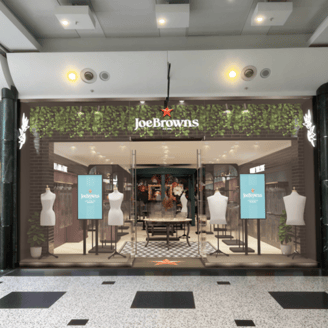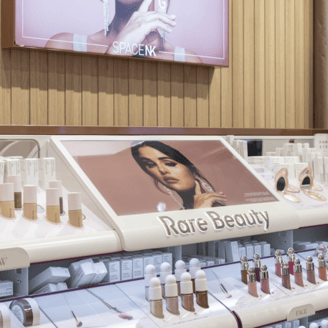Nov 7, 2023
Primark continues to shine; collabs, licensing, new stores and digital project are key
Nov 7, 2023
Primark owner Associated British Foods has reported strong results for the year to 16 September, with group revenue, rising 16% to £19.75 billion and the fashion chain's sales proving very strong.

Total adjusted profit before tax was up 9% at £1.473 billion, while unadjusted pre-tax profit rose as much as 25% to £1.34 billion.
Importantly for the fashion sector, Primark itself was a bright spot within the group (which also specialises in foods as the parent company's name suggests). Revenue in its retail division – which essentially means Primark globally/Penneys in Ireland – rose 17% to just over £9 billion and in constant currency, revenue rose 15%. Operating profit was up 30% at £717 million, but on an adjusted basis operating profit actually fell 3% to £735 million.
That dip came as the adjusted operating profit margin for the full year was 8.2%, down on the previous financial year's 9.8% due to its decision not to fully recover all the rises in input costs.
Primark revenues rose strongly, exceeding its earlier expectations. This reflected a sales increase in all its markets driven multiple factors, including “carefully selected price increases taken to partially offset high and volatile input cost inflation, well-received product ranges and the resulting appeal of our offer to new and existing customers”.
Good footfall, strongly performing new stores and the rollout of its enhanced customer website also made a positive impact and strong growth in sales was spread across the year. In H1 it was 17% and while H2 was particularly tough for the fashion sector, it still managed to rise 14%.
Like-for-like sales growth was 8.5% for the year, 10% in H1 (driven by higher average selling prices and higher unit volumes partially offset by smaller basket sizes), and 7% in H2.
Cold weather essentials and other seasonal lines, including its well-received velvet plush leggings, had driven strong sales leading into a record Christmas season, which included a resurgence in women's partywear, tailoring separates and beauty. Later, sales of beachwear and luggage were “exceptionally strong as customers looked early to holidays”. Its summer trading was good too, led by its boho-inspired design trend.
Collab strength
During the year, it expanded the premium essentials Edit offer across more stores and it sold well. It also continued its successful UK and European collaborations with Stacey Solomon, Kem Cetinay and Paula Echevarria, as well as launching its first truly international partnership with Rita Ora “whose first collection sales have surpassed expectations”.
Sales of licensed products grew significantly too, in particular over Christmas, including Disney, Netflix, The Grinch, and US sports partners NFL and NBA. The summer Barbie collection with Mattel also proved “very successful”.
Weather-wise, it saw good sales in early summer with the exception of Iberia “which suffered unusually poor weather in May”. In July, there was very bad weather in the UK/Ireland and heatwaves in Southern Europe, followed by warm conditions in August-September which coincided with the launch of AW23. “Despite these unseasonal conditions, we generally traded well with our core product ranges remaining in robust demand and partially offsetting inevitable volatility in sales more dependent on fashion and season,” it said.
Regionally, UK sales rose 11%, driven by like-for-like growth of 10% helped by that new customer website that has now been running for more than a year. Primark's market share grew from 6.4% last year to 6.7% this year.
In Europe excluding the UK, sales increased 18%, with like-for-like growth of 8% despite the weather issues. Its store estates in all countries delivered like-for-like sales growth, with good performances in Iberia, France, Germany, Belgium, the Netherlands and Eastern Europe. Italy continued to operate on high sales densities. It opened 17 stores in the region in the period with good resulting footfall. Sales densities in most of these new stores continue to be higher than average and its share of the total fashion market by value increased in both Spain and France.
US growth and digital initiatives
In the US, total net sales were 24% higher, driven by space expansion. It opened eight new stores, taking the estate to 21 stores, and is on track to meet its US expansion target of around 60 stores by the end of 2026.
The new locations are benefiting from its growing knowledge of the US consumer and the wider retail market.
Stores remain its focus but as mentioned, it has been boosting its digital capability and its “new and improved” website has been rolled out to all 16 markets. This has generated “a positive customer reaction and strong traffic uplift in all trading markets, led by the UK and the Republic of Ireland. Usage of the stock checker facility ranged broadly between 15%-20% of website sessions across our markets. We are also putting more focus on increasing traffic growth to www.primark.com through organic search, CRM and selected performance marketing trials and working in closer alignment with our already strong social media engagement. We believe our digital platform is already beginning to support good uplifts in footfall and that it is contributing to store like-for-like sales across our markets”.
It’s also been focusing on its Click + Collect trial, expanding it to an additional 32 stores in London, taking the total number offering this service to 57 stores, one third of its UK estate, and adding womenswear to them. Although it remains a trial, it’s “encouraged by the early results”.
Copyright © 2023 FashionNetwork.com All rights reserved.












